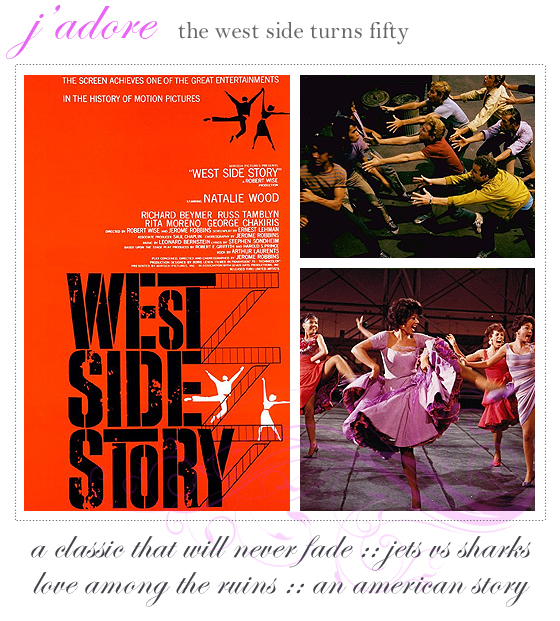
West Side Story, the classic Oscar-winning film just turned fifty, and this Birdie was thrilled to have a chance to see it in the theaters for the first time. To celebrate its golden anniversary, it was shown for one night in a few select theaters, and I was so very pleased to be able to see it on the big screen, as it's one of my favorite films. I love it for the music and Technicolor dream of over the top choreography, but it's more than just song and dance.
In 1961, West Side Story, originally adapted from a stage production, hit the big screens, celebrating the era of big musicals and dazzling audiences with the energy of a stage performance set against the real life backdrop of gritty New York City. This was something unusual, as a lot of musicals were shot in the safety and controlled environment of a stage, but from the opening shot of West Side Story, you know you're seeing something different -- a hybrid of fantasy and reality with the big, busy metropolis of NYC, an aerial view of its complex, maze-like pattern of streets and buildings, and a gradual dial-down into the West Side neighborhood where one simple, but meaningful story takes place.
Sure, it's basically Romeo and Juliet, so one could say Shakespeare started it all -- forbidden love tearing close knit communities apart. Kinda old-hat, you might think, but heaven knows we see this story told time and time again. I'm seeing constant ads for yet another freaking Twilight movie -- don't tell me that story is reinventing the wheel! When West Side Story came out fifty years ago, it was breaking norms of its own; the love story is just the surface plot that everyone can get on board with, but what makes this movie truly timeless is the fact it was willing to address the issue of race in America. The original stage version had a Jewish girl falling in love with a Catholic boy, and the title was East Side Story, but the film wanted to be relevant to what was happening in the city. At the time, there was a high influx of Puerto Rican immigrants to the neighborhood, raising tensions among the primarily white, Irish and Polish residents. The song and dance numbers, which are absolutely stunning and choreographed with incredible energy, is a sugar-coated debate over Whose America Is It, Anyway? Everyone is laying claim over this little strip of neighborhood, representing America itself, whether it's by birthright or a sense of Manifest Destiny to achieve personal success. Switch out the places and where people came from, but the tale sounds hauntingly familiar in so many areas in America today. This is the most poignant part of this film and why it continues to be celebrated as a classic, because despite its beauty as a musical, it serves as a valid argument over what it means to be an American, offering no clear, simple solutions. The actors seem like a squeaky-clean, idealized look at gang warfare, but the message remains as resonant as ever, that America is not my story, nor your story, but our story.
Jaunty Fine Print: Images from IMDB.com




No comments:
Post a Comment
Merci buttercups! Your comments are appreciated! (hit the 'post comment' button twice, sometimes it's buggy)